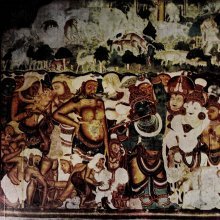External: 1 definition
Introduction:
External means something in Hinduism, Sanskrit. If you want to know the exact meaning, history, etymology or English translation of this term then check out the descriptions on this page. Add your comment or reference to a book if you want to contribute to this summary article.
Images (photo gallery)
In Hinduism
Yoga (school of philosophy)
Source: ORA: Amanaska (king of all yogas): A Critical Edition and Annotated Translation by Jason BirchThe External Mudrās are denoted by the Sanskrit term Bahis, according to the Śivayogadīpikā by Sadāśivayogīśvara: a text dealing with Śaivism and Haṭhayoga in two hundred and eighty-nine verses.—Accordingly, “Knowledge of the twenty-five Tattvas is that [Rājayoga] which is called Sāṅkhya. The [Rāja]yoga called Tāraka is [so called] because [it consists in] knowledge of external (bahis) Mudrā, and Amanaska is [so called] because [it consists in] knowledge of internal Mudrā. Tāraka is more laudable than Sāṅkhya and Amanaska is more laudable than Tāraka. Because it is the king of all Yogas, it is called Rājayoga”.

Yoga is originally considered a branch of Hindu philosophy (astika), but both ancient and modern Yoga combine the physical, mental and spiritual. Yoga teaches various physical techniques also known as āsanas (postures), used for various purposes (eg., meditation, contemplation, relaxation).
See also (Relevant definitions)
Starts with: External movement, External purification, External sign, External thought, External World, Outer universe.
Full-text (+1364): Bahya, Shataponaka, Bahira, Bahiranga, Vahishka, Bahyopacara, Bahyartha, Bahiryoga, Nishtya, Dantavaidarbha, Adhyatmabahirdhashunyata, Adhyatmika, Samvara, Anuttamambhasika, Nyastacihna, Vaideshika, Vyanjaka, Bahirang, Vaideshik, Anuttamambhas.
Relevant text
Search found 378 books and stories containing External; (plurals include: Externals). You can also click to the full overview containing English textual excerpts. Below are direct links for the most relevant articles:
Yoga-sutras (with Bhoja’s Rajamartanda) (by Rajendralala Mitra)
Sūtra 3.43 < [Third Chapter (Vibhuti Pada)]
Sūtra 3.29 < [Third Chapter (Vibhuti Pada)]
Sūtra 3.44 < [Third Chapter (Vibhuti Pada)]
Yoga Vasistha [English], Volume 1-4 (by Vihari-Lala Mitra)
Chapter LXVII - Abandonment of intrinsic relations < [Book V - Upasama khanda (upashama khanda)]
Chapter XI - Triads or triples or tripartite om in trinitarian systems < [The om tat sat]
Chapter L - On sensation and the objects of senses < [Book VI - Nirvana prakarana part 1 (nirvana prakarana)]
The Great Chariot (by Longchenpa)
Part 2 - Cutting the root of mind < [D. Abandoning]
3b) The suffering of the hungry ghosts < [Part 3 - The main divisions]
A. Entering into the nature of all dharmas, the unborn < [Chapter X - The view of prajña that realizes the ground without dwelling in dualistic extremes]
Dhammapada (Illustrated) (by Ven. Weagoda Sarada Maha Thero)
Verse 141 - The Story of Venerable Bahūbhāṇḍika < [Chapter 10 - Daṇḍa Vagga (Punishment)]
Verse 385 - The Story of Māra < [Chapter 26 - Brāhmaṇa Vagga (The Brāhmaṇa)]
Verse 47 - The Story of Viḍūḍabha < [Chapter 4 - Puppha Vagga (Flowers)]
Sumitranandan Pant < [April – June, July – September 1978]
The Message of Tagore < [July – September, 1990]
Vemana: The People’s Poet < [December 1948]
A Path to Peace 1 (by Ajahn Chah)
Related products
(+372 more products available)











